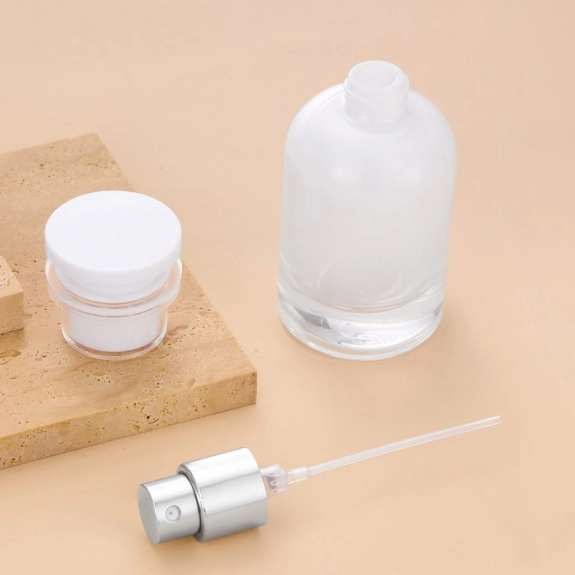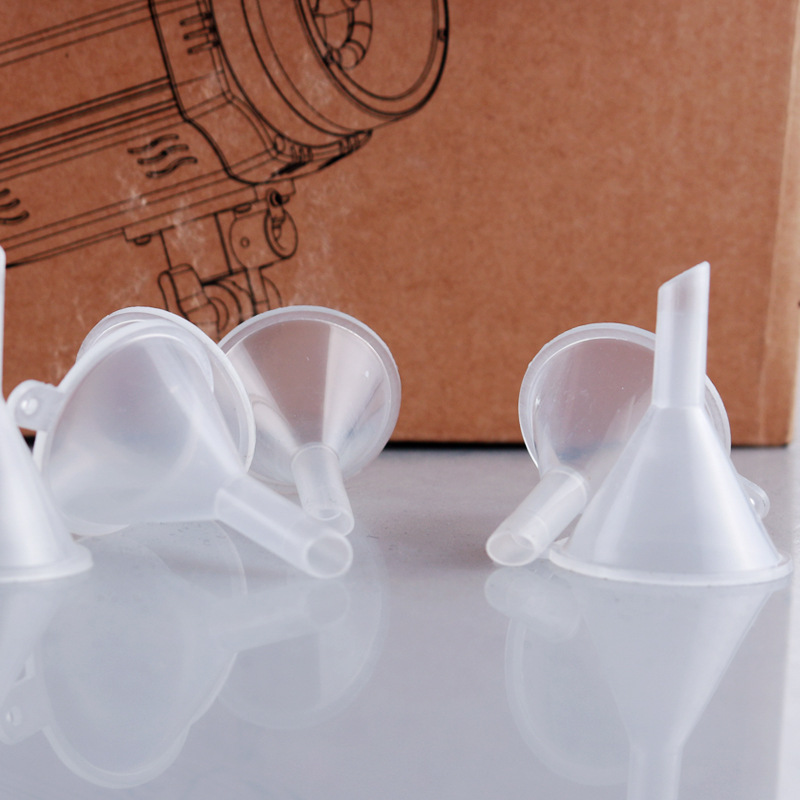
Understanding Different Types of Perfume Bottles
Common Materials
Perfume bottles blend function and beauty. They use various materials. Glass is widely used. It’s non-reactive. It preserves fragrance quality. Luxury perfumes favor it. Glass molds into intricate shapes. It shows the liquid’s color. Plastic is another choice. It suits travel or budget options. Plastic is light. It resists breaking. But it may not preserve as well. Metal parts, like aluminum, add flair. They’re used in spray systems or decor.
Types of Closures
The closure mechanism is an essential aspect of perfume bottle design as it ensures the fragrance remains sealed and uncontaminated. Screw caps are commonly found on simpler designs and allow easy access to the liquid. Crimped spray tops are widely used in modern perfume bottles, providing a convenient way to apply the fragrance evenly without exposing it to air. Glass stoppers are often associated with vintage or high-end perfumes, offering an elegant touch but requiring careful handling.
Identifying Refillable Bottles
Refillable bottles promote sustainability. They save money. They have removable closures. Some feature refill ports. Look for screw-off tops. Check for detachable nozzles. These signs mark refillable designs.
Tools and Preparations Needed for Refilling
Essential Tools
Opening perfume bottles needs specific tools. Small screwdrivers work for some caps. Pliers with rubber grips help. Specialized bottle openers are ideal. They’re made for cosmetic containers. For crimped spray tops, use a decapping tool. It removes metal seals safely.
Safety Precautions
Perfume bottles are delicate. Spills are risky. Work on a flat surface. Cover it with a soft cloth. This prevents slips. It avoids breakage. Wear gloves if needed. They protect against sharp edges. Strong scents can irritate skin. Handle with care.
Step-by-Step Guide to Opening a Perfume Bottle
Removing Screw Caps
Hold the bottle steady. Use one hand. Twist the cap counterclockwise. Use the other hand. If it’s stuck, add traction. Try a rubber grip pad. Or wrap a cloth around it. Don’t force it. Too much pressure cracks glass. It can strip threads.
Dealing with Crimped Spray Tops
Use a decapping tool. It’s designed for crimped tops. Place it around the metal crimp. It’s at the nozzle base. Squeeze gently. Lift until the crimp loosens. Remove it carefully. Avoid damaging the bottle’s neck. It’s fragile.
Removing Glass Stoppers
Hold the bottle firmly. Twist the stopper gently. Pull it out. If it’s stuck, use warm water. Run it over the bottle’s neck. Avoid labels. This expands the glass slightly. For tough stoppers, wrap them in cloth. Use pliers softly. Apply even pressure.
Tips for Refilling Your Perfume Bottle Properly
Preventing Spills
Refilling perfume is delicate. Concentrated scents are costly. Work on a stable surface. Cover it with a soft cloth. It catches drips. Use a perfume funnel. Its narrow neck ensures precision. It reduces waste. A pipette or dropper helps too. They control liquid flow.
Hold the bottle securely. Avoid tipping it. Use tools gently. Pliers or decapping tools can cause jerks. This leads to spills. Keep tissues nearby. Absorbent towels work too. They clean leaks fast.
Cleaning Before Refilling
Clean bottles thoroughly before refilling. Old scents alter new ones. Rinse with warm water. Add mild soap. Avoid harsh chemicals. They react with fragrances. They damage materials.
For stubborn oils, use rubbing alcohol. Pour a small amount in. Shake well. Rinse with water. Let the bottle air dry. Ensure no moisture stays. It can dilute perfume. It may spoil it.
For intricate designs, use a small brush. Cotton swabs work too. They reach tight spots. Regular cleaning keeps bottles beautiful. It maintains spray function.
Troubleshooting Common Issues When Opening a Perfume Bottle
Handling Stuck Closures
Stuck closures are common. They need patience. For screw caps, use a rubber grip pad. Wrap it around the cap. Twist counterclockwise. If it doesn’t move, try warm water. Run it over the cap. Avoid labels. This loosens the grip.
Crimped spray tops are trickier. Use a decapping tool. Place it around the crimp. It’s at the nozzle base. Apply gentle pressure. Lift slowly. This removes the seal.
Glass stoppers need care. Twist and pull gently. Hold the bottle steady. If stuck, use warm water on the neck. Wrap the stopper in cloth. Use pliers lightly. Don’t force it. This risks breaking.
Avoiding Damage
Incorrect opening harms bottles. It affects spray systems. Use proper tools. Small screwdrivers are good. Specialized openers are better. Avoid household items. Knives can scratch. They may crack glass.
For crimped tops, don’t press hard. The bottle’s neck is fragile. Prying with sharp tools chips parts. It breaks plastic or glass. Wear nitrile gloves. They protect hands. Sharp edges can cut. These steps preserve bottles. They ensure multiple uses.
Additional Tips for Successful Refilling
Choosing the Right Perfume
Select compatible fragrances. Mixing scents is risky. Chemical reactions change aromas. Stick to one perfume per bottle. Check the bottle’s capacity. Don’t overfill. Leave space for the spray mechanism. This ensures proper function.
Storing Perfume Bottles
Store bottles properly. Keep them cool. Avoid sunlight. Heat degrades fragrances. Use a dark place. A drawer works. Ensure bottles are sealed. This prevents evaporation. It maintains scent strength.
Testing the Spray Mechanism
After refilling, test the spray. Press the nozzle gently. Check for even mist. If it clogs, rinse the nozzle. Use warm water. Dry it fully. This restores function. It ensures smooth application.
Practical Steps for Beginners
Gathering Supplies
Start with the right tools. Buy a perfume funnel. Get a pipette or dropper. Have rubbing alcohol ready. Keep mild soap on hand. Stock tissues or towels. A soft cloth is essential. These prepare you for refilling.
Practicing on Old Bottles
Practice makes perfect. Use empty bottles first. Try opening them. Clean them thoroughly. Refill with water. This builds skill. It avoids wasting perfume. It boosts confidence.
Seeking Professional Help
If unsure, consult experts. Perfume shops offer advice. Some refill bottles. They use specialized tools. This ensures safety. It prevents damage. It’s ideal for high-end bottles.
Maintaining Perfume Bottle Quality
Regular Inspections
Check bottles often. Look for cracks. Spot loose closures. Inspect spray nozzles. Faulty parts cause leaks. Fix issues early. This extends bottle life. It protects fragrances.
Proper Handling
Handle bottles gently. Avoid dropping them. Glass is fragile. Plastic can crack. Use both hands when opening. This prevents slips. It ensures steady control.
Recycling Old Bottles
If bottles can’t be refilled, recycle them. Glass is recyclable. Check local rules. Remove metal parts first. Clean bottles before recycling. This supports sustainability. It reduces waste.

Frequently Asked Questions
How to know if a bottle is refillable?
Check for screw-off tops. Look for removable nozzles. These mark refillable designs.
What if a glass stopper is stuck?
Use warm water on the neck. Avoid labels. Twist gently. Try cloth-wrapped pliers.
Can I mix perfumes in one bottle?
Avoid mixing. Scents may react. This changes their aroma.
Are there special tools for opening bottles?
Yes. Decapping tools help. They safely remove crimped tops.
Contact Yiwu Yujin Import & Export Co., Ltd. for tailored perfume bottle solutions. Their customization services meet your needs!




